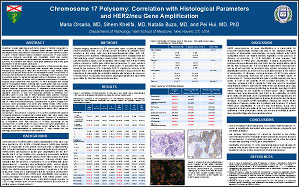Chromosome 17 Polysomy: Correlation with Histological Parameters and HER2/neu Gene Amplification
Maria Orsaria, MD, Sihem Khelifa, MD, Natalia Buza, MD, and Pei Hui, MD, PhD
Departments of Pathology, Yale School of Medicine, New Haven, CT, USA
ABSTRACT
Objective:
Human epidermal growth factor receptor 2 (HER2) oncoprotein is overexpressed in 15% to 20% of invasive breast cancers, with HER2 gene amplification being responsible for overexpression in the vast majority of cases. A subset of breast cancers harbors increased chromosome 17 copy number (polysomy), frequently associated with comparable HER2 copy number increase. We investigated the clinicopathologic significance of chromosome 17 polysomy in correlation with various histological parameters and HER2 gene amplification in breast invasive carcinomas.
Materials and Methods:
Surgical staging specimens of 266 consecutive cases of primary invasive breast carcinomas were selected from a single tertiary medical center. HER2gene status and chromosome 17 copy numbers were assessed by dual-color fluorescent in situ hybridization (FISH). Chromosome 17 polysomy was determined by the presence of ≥3 average CEP 17 (chromosome enumeration probe 17) signals per average nucleus of 30 invasive tumor cells.
Results:
Of 266 cases, 63 tumors (23.7%) harbored chromosome 17 polysomy. Invasive breast carcinomas with polysomy 17 were associated with several adverse histological indicators including high nuclear grade, high tumor grade, high Nottingham Prognostic Index (NPI), high tumor stage and lymphovascular invasion. Moreover, cases with polysomy 17, compared to non-polysomy cases, had greater estrogen receptor (ER) positivity and progesterone receptor (PR) negativity. Polysomy 17 was more frequently observed in HER2/neu non-amplified cases (71.4%) than in HER2 amplified cases (23.8%). However, polysomic cases were more often HER2 3+ by immunohistochemistry (17.5%) than non-polysomy cases (5.9%). A total of 11 (17.5%, 11/63) polysomy cases had 3+ HER2 immunohistochemistry, compared with 12 (5.9%, 12/203) non-polysomy cases (p=0.0202). Five cases (2%, 5/266) showed HER2 protein overexpression (3+ immunohistochemistry) but failed to demonstrate HER2 gene amplification by FISH, none of which had more than 6 CEP17 signals per average nucleus.
Conclusions:
The presence of polysomy 17 is closely correlated with adverse histological parameters including high nuclear grade, high tumor grade, high NPI, high tumor stage and lymphovascular invasion. Polysomy 17 is common to both HER2 amplified and non-amplified tumors. Upregulation of the transcription by a mechanism other than polysomy 17 is likely responsible for the overexpression of HER2 protein in tumors without the gene amplification. In conjunction with the literature, our findings further highlight the need to incorporate the determination of chromosome 17 copy number into the pathology assessment of invasive breast carcinoma.
©2012 Yale Department of Pathology. All rights reserved.
Any redistribution or reproduction of part or all of the contents in any form is prohibited. You may not, except with express written permission of the author or the Department of Pathology, distribute or commercially exploit the content, nor may you transmit it or store it in any other website or other form of electronic retrieval system, including use for educational purposes.
